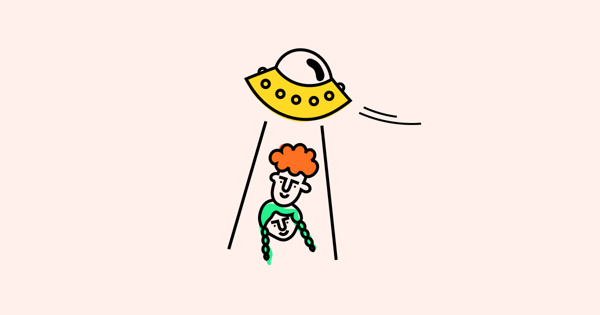Existing customers are one of your greatest assets as an ecommerce marketer.
They’re people who liked your messaging and product enough to purchase from you at least once — and with a little gentle persuasion, they’ll buy again.
According to Gorgias, repeat customers account for 44 percent of revenue and 46 percent of orders, despite representing just 21 percent of an average ecommerce brand’s customer base.
Yet customer retention is still criminally overlooked in the ecommerce world.
A survey from Omniconvert found that only 20 percent of ecommerce professionals have a dedicated budget for customer retention, while 63 percent allocate more budget to acquisition than retention.
![]() We get it: you need a constant stream of new customers to hit your growth goals.
We get it: you need a constant stream of new customers to hit your growth goals.
But that doesn’t mean you can afford to sacrifice customer retention.
To help you turn more first-time buyers into loyal repeat shoppers, I wrote this guide to explain:
- How ecommerce retention rates work
- What a “good” ecommerce retention rate looks like
- How you can boost your current retention rate
Let’s get into it…

Table of Contents
- What is Ecommerce Retention Rate?
- How to Calculate Ecommerce Retention Rate
- What Is a Good Retention Rate for Ecommerce?
- 4 Strategies to Improve Your Retention Rate
- 3 Examples of Retention Email Marketing
What Is Ecommerce Retention Rate?
Ecommerce retention rate is the percentage of customers who keep buying from you over a given time period.
As such, it’s the inverse of another key ecommerce metric, customer churn rate.
If your store attracts a ton of repeat business, your ecommerce retention rate will be high. But if you typically “lose” customers after a single purchase, your retention rate will suffer, making it harder to achieve your revenue targets.
Key Retention Rate Ecommerce Metrics
Ecommerce retention rate isn’t the only way to analyze your ability to build long-lasting, profitable customer relationships. Other metrics to keep tabs on include:
- Customer churn rate: The percentage of customers who ditch you over a given period.
- Revenue churn rate: Like customer churn rate, except applied to the revenue you’ve lost over the period you’re measuring.
- Customer lifetime value: The amount of revenue you earn from customers before they churn. For instance, if your average customer places 3X $50 orders in their “lifetime” with your brand, your CLV is $150.
- Customer loyalty rate: The proportion of customers who sign up for your loyalty program.
How to Calculate Ecommerce Retention Rate
Ecommerce retention rate is (relatively) easy to calculate. But before you crunch the numbers, you need three pieces of information:
- The number of customers you had at the start of the period you’re measuring.
- The number of customers left at the end of that time period.
- How many new customers you won during the period.
Plug that data into the following formula to calculate your ecommerce retention rate:
[(Number of customers at the end of time period – Number of customers acquired during time period) / Number of customers at the beginning of time period] x 100
For example, let’s say a DTC brand had 1,000 at the start of a month and 750 at the end.
Along the way, they acquired a further 500 customers.
That gives us the following calculation:
- Number of customers at the end of time period – Number of customers acquired during time period (750 – 500) = 250
- 250 / Number of customers at the beginning of time period (1,000) = 0.25
- 0.25 x 100 = 25 percent ecommerce retention rate
What is a Good Retention Rate for Ecommerce? (Benchmark)
If this is your first time analyzing your retention rate, it can be helpful to understand how other brands are performing.
Obviously, you can’t dig into their backends and pull the figures yourself. But there’s some solid ecommerce retention rate data floating around, which can at least give you a vague idea of how you shape up against the competition.
For instance, Omniconvert asked 450+ ecommerce professionals about their retention rates.
Almost one-third didn’t know, which isn’t very helpful.
But the highest proportion of respondents said their ecommerce retention rate is from 16 percent to 30 percent.
![]() There are a couple problems with this benchmark data:
There are a couple problems with this benchmark data:
First off, 16 percent — 30 percent is a pretty broad range. If your retention rate is 17 percent, are you an “average performer”? Or are all the other brands in that group actually seeing rates closer to 29 percent?
Secondly, overarching benchmarks will only get you so far. A brand selling fast-moving consumer goods — like makeup or toothpaste — is practically guaranteed to have a higher retention rate than one selling high-ticket items like mattresses or furniture.
Because customers will run out and need more quicker. If you’re selling big-ticket items, your product purchase cycle is likely to vary.
So you might want to search around for some more industry-specific numbers.
For instance, Metrilo analyzed data from its client base to identify the average ecommerce retention rate across multiple niches, ranging from 20.9 percent in “tea” to 36.2 percent in “CBD”:
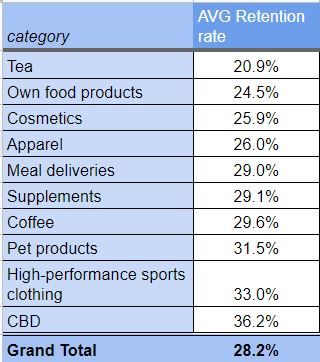 But even brands within the same vertical might have widely different figures.
But even brands within the same vertical might have widely different figures.
Take pet supplies as an example: I’d expect the average pet food brand to have a higher retention rate than one selling cat beds or dog grooming brushes, because they’re more likely to see repeat purchases.
For that reason, we recommend not paying too much attention to benchmarks. Instead, focus on improving your current ecommerce retention rate — however high (or low) it might be.
Or, as the great Ella Fitzgerald put it: “It isn't where you came from. It's where you're going that counts.”
4 Strategies to Improve Your Ecommerce Retention Rate
So we’re agreed:
Whatever your current ecommerce retention rate, there’s always room for improvement.
Here are four strategies to help you take customer retention to the next level…
1. Limit (the Impact of) Stock Shortages
Stock shortages are a massive issue where retention rates are concerned, with 59 percent of consumers saying they feel less confidence to keep shopping with a retailer if they experience regular stockouts.
Unfortunately, few ecommerce brands can control every element of their supply chains. That means stockouts are often hard to avoid.
So should you just ignore it and hope everything works out okay?
Of course not. Even if stock shortages are a fact of life, there’s still plenty you can do to limit their impact.
For instance, Zara points customers toward similar products when their first-choice purchases are out of stock:
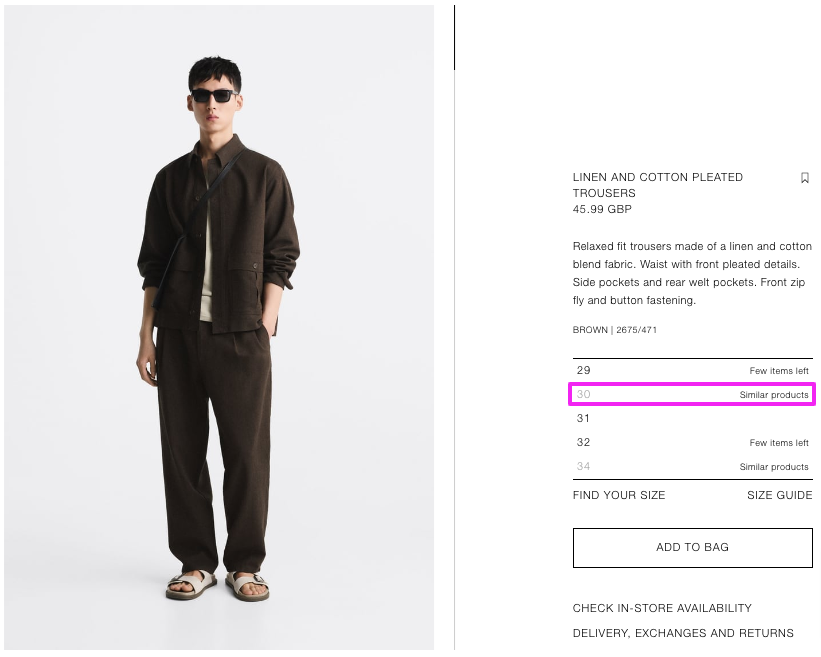
You could also add pre-order functionality to your website, allowing customers to reserve — or pay in advance for — a product that’s not currently available.
Either way, it’s about showing customers that their business is important and you want them to keep buying from you.
2. Deliver Personalized Experiences
Consumers want to be treated like individuals, not walking wallets.
Excitingly for ecommerce brands, they’re happy to reward retailers that meet their expectations. According to Twilio, 60 percent of consumers will likely become repeat buyers after encountering a personalized shopping experience.
Fortunately, personalized experiences needn’t be overly complex.
In fact, they’re often most effective when shoppers don’t even realize they’re happening.
For instance, ballet shoe brand Butterfly Twists automatically updates its product price and size information based on the customer’s location:
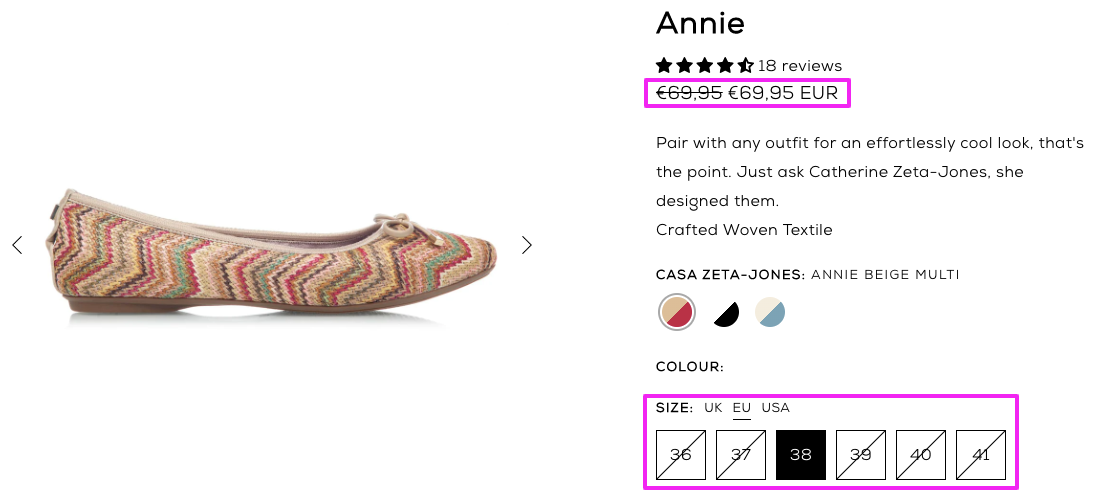 It’s not always about wowing (or scaring) your audience by revealing every single thing you know about them.
It’s not always about wowing (or scaring) your audience by revealing every single thing you know about them.
Instead, focus on using personalization to streamline the shopping experience. Because if customers find it a cinch to buy from you, there’s a good chance they’ll come back time and again.
3. Nail Your Post-Purchase Comms
Buying from a new ecommerce store can be a pretty stressful experience — especially if you’ve never heard of the brand before.
You’ve Googled: “Is [brand] legit?”
It didn’t set any alarm bells ringing, so you went ahead and placed an order. So far, so good.
But you still want to feel confident that everything’s progressing smoothly. And if you don’t hear anything, there’s a good chance you’ll think something’s gone wrong.
For that reason, order confirmation emails — those sent after a customer makes a purchase — play a vital role in boosting ecommerce retention rates.
According to Silverpop, transactional emails (which include order confirmations) see an average unique open rate of 45 percent, which is over twice as high as other email types.
As with so much in the world of marketing, effective order confirmation emails needn’t be too complex.
Take a leaf from Bestseller’s book by summarizing the order, telling the customer what happens next, and explaining how to reach out if they have any further questions:
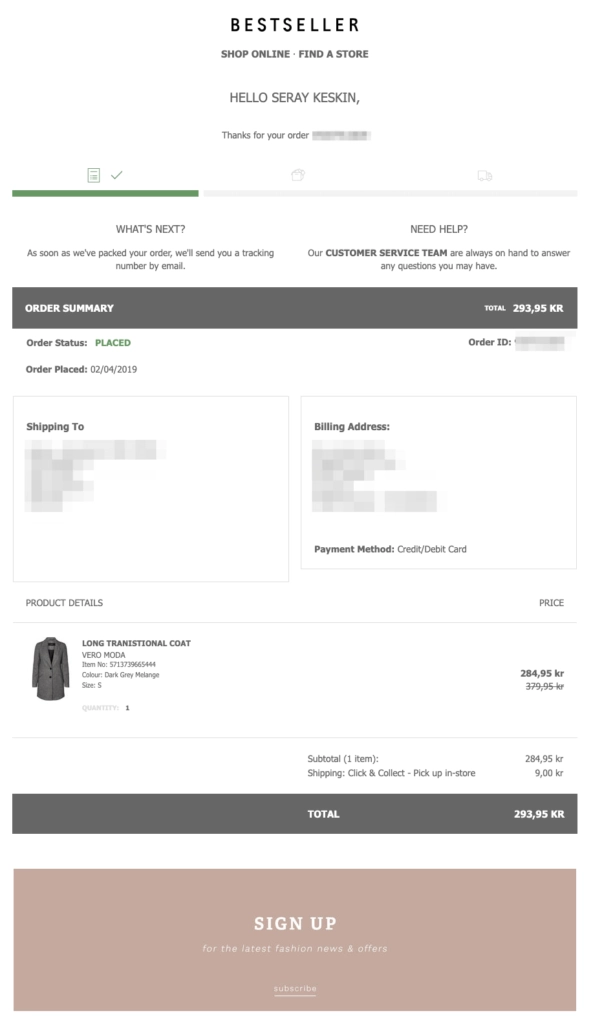
4. Help Customers Make Sustainable Choices
Once upon a time, being a successful retailer meant little more than selling a decent product at an attractive price point.
Of course, that stuff’s still important. Indeed, research from CGS found that product quality is still the #1 factor dictating whether a customer is likely to return to a brand.
But the second-biggest factor — sustainable and ethical business practices — shows that consumers increasingly want to deal with companies whose values align with their own.
Patagonia is arguably the most famous example of a brand built on sustainable principles.
Its website features a landing page spelling out its eco-friendly credentials…
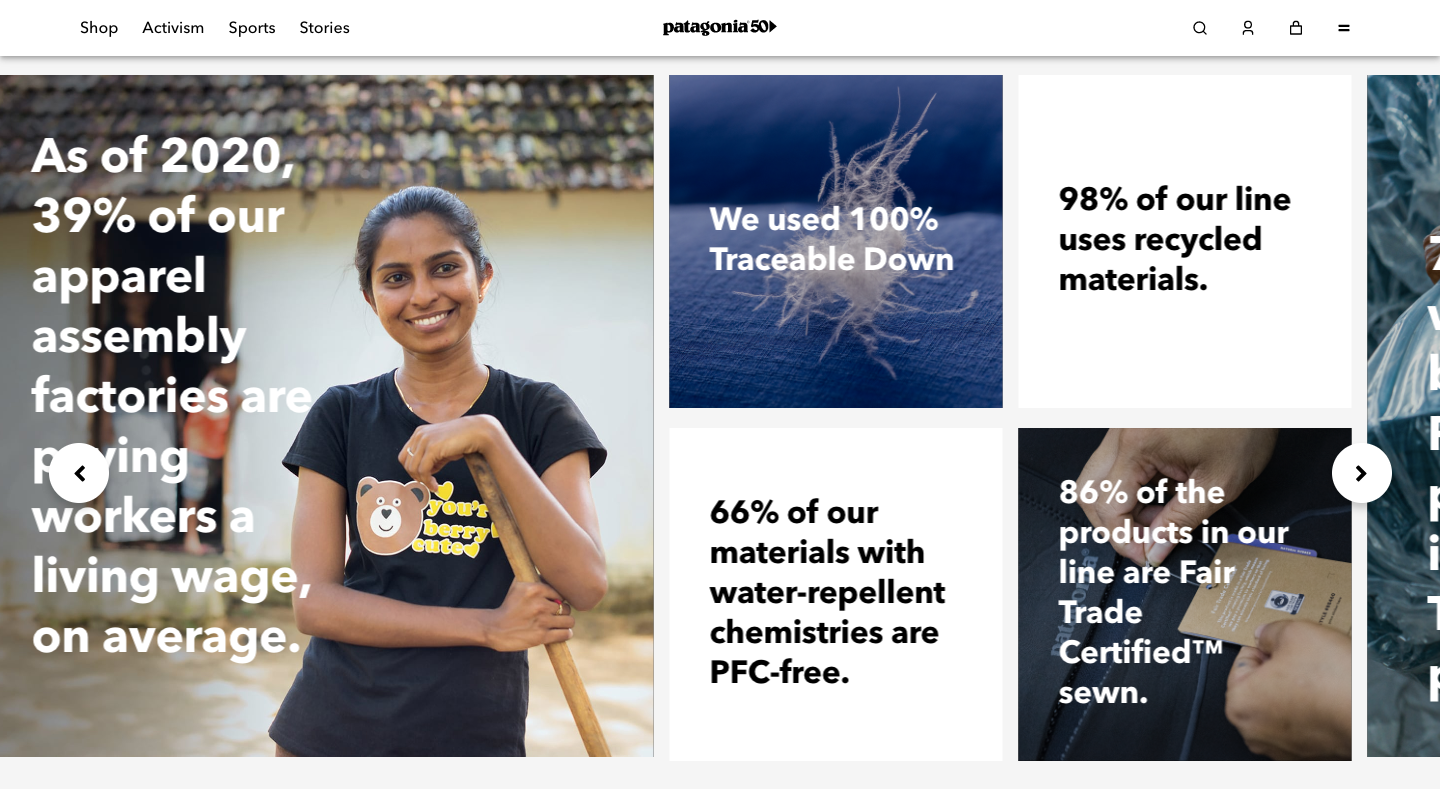 …and it supports a wealth of good causes, from community-owned energy projects to Europe’s first wild river national park.
…and it supports a wealth of good causes, from community-owned energy projects to Europe’s first wild river national park.
Sure, you might not have Patagonia’s resources. But you can still demonstrate how you’re reducing your carbon footprint or using more sustainable packaging.
Just don’t offer empty words, because 34 percent of consumers actively research brands to ensure they follow through on their sustainability-related promises.
3 Examples of Ecommerce Retention Email Marketing
Email marketing is a key channel for retaining customers and revenue, with four-fifths of small businesses using email to aid retention.
Let’s look at three real-world examples of brands leveraging email marketing as part of their ecommerce retention strategies…
1. Chairish: Reward Long-Standing Customers
It stands to reason that if you reward customers for sticking with you through thick and thin, they’re more likely to keep buying from you.
One way to do that is by offering discount codes, free shipping, free gifts, or some other promotion to mark key milestones, such as anniversaries and birthdays.
Vintage and contemporary furniture marketplace Chairish shows us how to do it here:
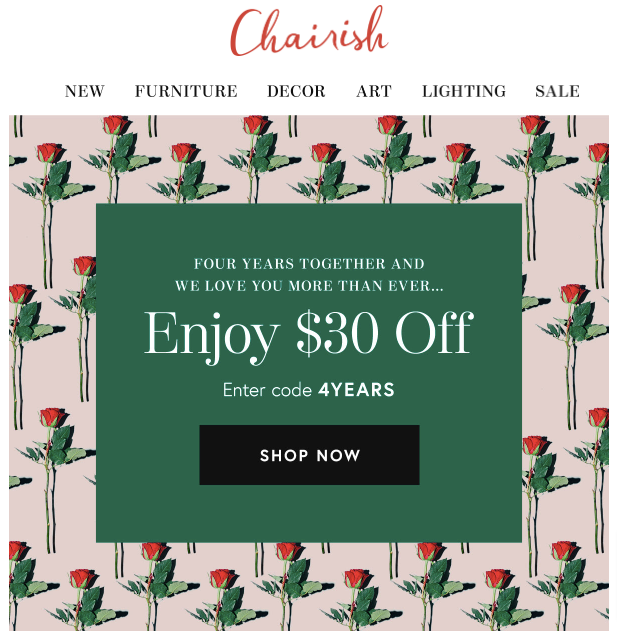
2. Bloom & Wild: Reach Out to Customers Post-Delivery
Put yourself in the shoes of a customer buying from your store for the first time:
They like the look of your product. They were won over by your messaging and reviews. But they’re still not 100 percent certain what to expect when their purchase arrives.
You can make their lives a whole lot easier by sending a helpful post-delivery email that tackles frequently asked questions.
Here’s a fantastic example from flower delivery company Bloom & Wild:
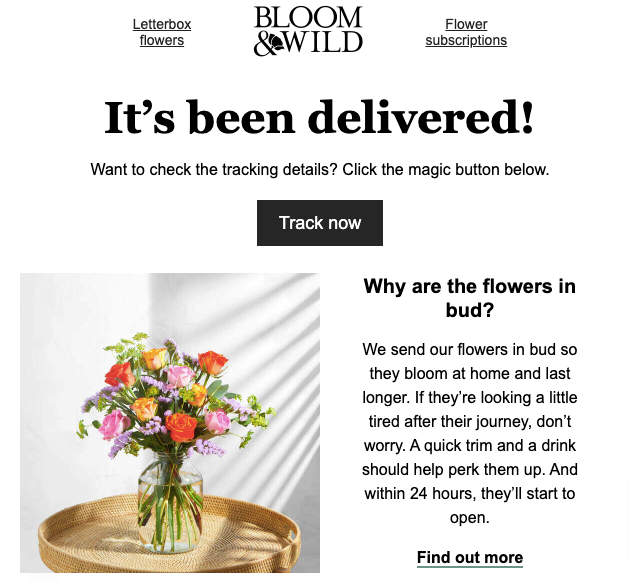 Immediately, customers understand why their flowers might not look exactly as they expected. And they know how to keep their new, be-petalled companions looking their best for as long as possible.
Immediately, customers understand why their flowers might not look exactly as they expected. And they know how to keep their new, be-petalled companions looking their best for as long as possible.
That means more satisfied customers and a higher chance of repeat purchases.
3. Johnny Cupcakes: Share Loyalty Program Progress
Loyalty programs are an extremely effective way to improve your ecommerce retention rate and drive more repeat orders.
Indeed, research from McKinsey & Company reveals that top-performing loyalty programs can increase revenue from points-redeeming customers by 15 percent to 25 percent annually.
Of course, if your loyalty program’s going to deliver the desired results, customers need to buy into the benefits.
Clothing brand Johnny Cupcakes does this by sharing regular updates on customers’ loyalty progress:
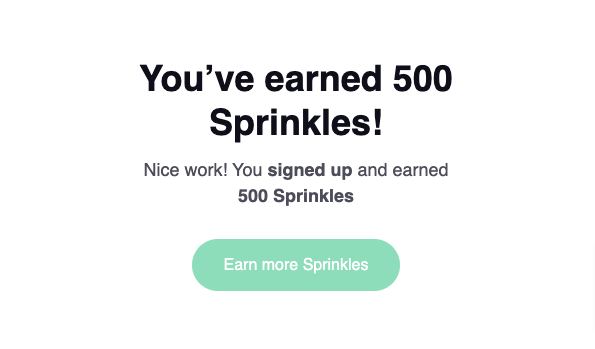 That way, loyalty members understand how much they’ve already earned, giving them the impetus to unlock more rewards.
That way, loyalty members understand how much they’ve already earned, giving them the impetus to unlock more rewards.

Boost Your Ecommerce Retention Rate With Drip
As I’ve already noted, personalization plays a key role in helping ecommerce brands retain customers.
Effective personalization relies on segmentation. And when it comes to ecommerce segmentation, Drip is in a class of its own.
We pull in all your data — store, integrations, onsite, and email—to help you communicate with customers on a 1:1 level at exactly the right time to drive action.
More sales. More loyal customers. More repeat customers.
But don’t take my word for it; see for yourself by signing up for your 14-day free trial.
